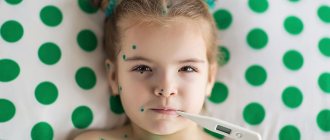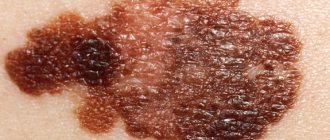01 August 2018
Averyanova Sveta
It’s hard to imagine raising a child without frequent walks.
The point of view of modern pediatricians is this: the child should be in the fresh air every day, even if unwell. But there is no exact answer to the question of whether it is possible to walk with chickenpox. It all depends on many circumstances: weather conditions, the well-being and age of the baby, the severity of the disease.
Why can't you go for a walk?
Susceptibility to infection is almost 100%, that is, if the virus enters the body, a person who has not previously encountered it will definitely get sick. In accordance with the name, infectious agents are capable of moving with air flow at a distance of up to one hundred meters from the carrier of the virus.
There are no obstacles for it in the form of natural objects: trees and bushes; it can be transmitted in transport and public spaces, penetrate through ventilation shafts and elevator cabins. The virus is unstable in the air and persists for about 10 minutes; it quickly dies when exposed to heat and light.
Children tolerate chickenpox relatively easily, but there are groups of people for whom exposure to the virus can lead to serious complications, including death:
- Newborns and infants up to one year old. The course of infection in such children, due to the immaturity of the immune system, can be severe, cause false croup, and complicate the functioning of internal organs.
- Pregnant women who have never had chickenpox. In this case, the unborn baby is at risk. At certain periods, the disease can cause developmental abnormalities: deformity, organ damage, miscarriage.
- Teenagers and adults. A child who did not have chickenpox in early childhood, as a rule, suffers severely and for a long time at a later age. There is a high probability of disruption of the nervous and cardiovascular systems, complications in the form of pneumonia, encephalitis and meningitis.
- People with reduced immunity. People with HIV syndrome, patients after organ transplantation, and the elderly are at risk. In rare cases, chickenpox can become infected again.
Walking is also unsafe for a small carrier of the virus. During periods of the appearance of vesicles, the skin's sensitivity to ultraviolet radiation increases. Exposure to sunlight threatens to aggravate the severity of the disease.
Even if it occurs in a mild form, due to the weakening of the body’s defenses, there is a threat of infection with other infections, especially if the baby is sick. And the baby will get tired faster. Walking during the acute phase can cause deterioration and complications. Therefore, the best option is to stay at home for the time determined by a specialist.
When deciding whether it is possible to go outside if you have chickenpox, you should also think about the moral aspect of walking. How many parents will be happy to see a child covered with a bright rash next to their child? Seeing the negative reaction of others, your baby may become frightened and suffer psychological trauma.
Symptoms of chickenpox in children
The initial manifestations of the disease resemble typical signs of a viral infection and are expressed in:
- sore throat;
- general malaise, weakness, body aches;
- capricious behavior;
- sleep disturbance;
- loss of appetite;
- headache;
- increase in body temperature. The more severe the disease, the higher the thermometer rises. With mild flow, the temperature may remain within normal values or rise slightly.
- A severe form of chickenpox is accompanied by vomiting, and the lymph nodes may become enlarged.
Simultaneously with the rise in temperature, a rash appears on the child’s body, by which chickenpox can be distinguished from other infectious diseases. Rashes with this disease are observed in the vast majority of cases. And even the mildest form is accompanied by a minimal amount of characteristic bubbles.
The rash is first noticed on the body, then on the arms, legs and head. There are no blisters on the feet and palms, but they often appear on mucous membranes: in the mouth, on the tongue and palate, on the genitals and eyes. Small red spots quickly turn into papules that resemble insect bites. Then liquid forms inside them. After the bubble is opened, a crust appears on it. The whole process is accompanied by severe itching, which causes discomfort to the child and sometimes even interferes with proper sleep. If the inflammations are not scratched, they will disappear without a trace soon. Otherwise, scratching may leave small scars on the skin.
It is important to explain to your child that you should not pick off scabs or scratch the inflamed areas, as you can introduce infection into the wounds, which will lead to complications.
The symptoms described above are typical manifestations of chickenpox. Atypical forms come in several types:
- bullous chickenpox with large purulent vesicles;
- hemorrhagic with bloody contents of vesicles;
- gangrenous-necrotic, in which the vesicles are filled with both blood and pus;
- rudimentary, which occurs without a rash and fever, only with typical signs of ARVI.
It is impossible to say for sure how many days chickenpox lasts. The first rash may appear on the first or second day of illness, the last - after a week or a week and a half. Healing of the skin will occur in one to two weeks. If there are complications, the illness may last for several weeks.
How long can you go for a walk?
the 5th day has passed from the last wave of blistering.
The period of elevated temperature ranges from 2 to 8 days; usually the baby himself does not show any desire to leave the house.
It would be wise not to go outside in unfavorable weather conditions: hypothermia is unacceptable these days.
It is important to know. A fashion for “chickenpox parties” has appeared in Russia. Parents take their children to visit their sick child so that they become infected at an early age and receive lifelong immunity. “Advanced” parents even offer others lollipops licked by a sick child. Doctors warn: there is a risk of overestimating the strength of the body's defenses and becoming seriously ill. It is better to get a vaccination, which most children tolerate easily. The famous doctor Evgeniy Komarovsky also expresses his opinion on the desirability of vaccinations.
Why are walks prohibited?
Preparing for HSV analysis and deciphering it
Why can't you go outside if you have chickenpox? As already noted, there is a high probability of infecting other people. The herpes virus is characterized by volatility and can be transmitted over hundreds of meters.
If the patient has a fever or a rash continues to appear, then walking is strictly prohibited. A simple walk can become a factor for another infection, which will occur due to a weakened immune system.
Against the background of the acute period of the disease and the active phase of the rash of pathological elements, patients are prohibited from being in the sun. Exposure to ultraviolet rays negatively affects the condition and can aggravate the course of the pathology.
Note: many children who have had chickenpox have high skin sensitivity to sun exposure.
The benefits of being outside
It is quite difficult for a baby to stay at home for 2-3 weeks; confinement at home quickly becomes unbearable. If the room is hot, the itching of the skin becomes unbearable. Ventilation gives relief only when the window is open. Fresh air will reduce symptoms of the disease and improve the mood of mother and child.
If the general condition of the small patient does not cause concern, walks in the fresh air can begin in the absence of fever. Usually the child returns to normal on the tenth day from the onset of the disease. However, he remains a carrier of the virus and is dangerous to others.
It is important to know. A mask worn on a child to reduce the risk of transmitting the virus to other people is useless for chickenpox: tiny particles of saliva easily penetrate through it.
Chickenpox: when can you walk and wash?
- Doctors' opinions on bathing with chickenpox vary significantly. In European countries, doctors are convinced that a child should not be prohibited from swimming. Clean water will wash away bacteria from his body that cause new rashes.
- Domestic doctors are of the opinion that it is better to refrain from swimming. They believe that taking a bath will only prolong the treatment time. If the child suffers from severe itching, you can wipe his body a little with a damp towel dipped in a weak manganese solution.
It is better to postpone a long bath after overcoming the illness.
As you can see, a child with chickenpox is allowed to walk in the fresh air. But, several rules must be followed. First, wait until your symptoms subside. Secondly, give preference to places where there are no heavy crowds of people. Remember that it is important to coordinate all actions with your doctor in order to maintain the child’s health. Be healthy.
Articles about children on the site:
- A child is angry: what to do, how to react
- Top 9 sports for children's development
- A child is bullied at school - what to do about it?
- Finger gymnastics, finger games for children 2-3, 4-5, 6-7 years old
- Fire prevention signs and reminders for children
When can you go outside?
Rainy autumn or spring is not the best time for walking. The wind will spread the virus over a long distance. Frost outside will cause hypothermia, the baby may be sick for a long time and get complications. The optimal conditions for walking in winter and in the off-season are calm weather with no precipitation and low solar activity.
When deciding whether to go for a walk or not, focus on the baby’s condition. While bubbles are appearing, it is unwise to take a walk.
The minimum period of home isolation is 10 days; if a child is moderately or severely ill, it lasts up to three weeks.
On the fifth day from the appearance of the last bubble, you can safely go outside. To track this point, it is recommended to smear the emerging vesicles with brilliant green.
Consider the age of the baby: a one-year-old baby is more vulnerable than a preschooler.
Chickenpox treatment
- The child's nails should be neatly trimmed. Not only can claws scratch the skin, but the mourning crescents under children’s nails are a real breeding ground for infection. If the child is very small, put on cotton mittens.
- Change your underwear daily. T-shirts and shirts should only be made from natural materials, preferably not very new. You can even give your baby your nightgown or T-shirt. The worn fabric is soft and will not bother the baby.
- Pay attention to the bedding. Save the starched sheets for another time - they are not soft enough for someone with chickenpox.
- Try to keep the temperature at home comfortable, do not wrap your baby up, sweat increases the itching.
- And of course, the most effective means is your love and all kinds of entertainment. These types of distractions help a lot!
- Lubricate the bubbles with your choice of a weak solution of potassium permanganate (1-2%), an aqueous, alcoholic solution of brilliant green (1-2%), a solution of fucarcin, a solution of rivanol (0.05%) or an aqueous solution of methylene blue (1%). This will help dry out the bubbles.
- If your baby has rashes on the oral mucosa, regularly rinse with a weak solution of furatsilin or miramistin.
- If the itching does not subside, you can consult a doctor about prescribing antihistamines to a child with chickenpox.
- Pay attention to your baby's drinking regimen when he has chickenpox. Juices (preferably diluted in half with water), rosehip decoction, cranberry juice, blackcurrant tea must be present in his menu.
- Don’t forget about general strengthening agents – vitamins. This will help you get rid of chickenpox much faster.
Vsevolzhsk Clinical Interdistrict Hospital
INDICATIONS FOR CALLING A DOCTOR, A THERAPIST, A GENERAL PRACTITIONER: 1) an increase in general body temperature above 38º with the impossibility of visiting a doctor in the clinic (severe general weakness); 2) ARVI and influenza during the epidemiological season; 3) acute infectious diseases accompanied by nausea, vomiting, and repeated loose stools; 4) increased blood pressure with manifestations of cerebral symptoms (headache, dizziness, nausea, vomiting, general weakness); 5) intense pain in the spine and joint pain; 6) chronic painful conditions that do not allow the patient to visit the clinic on their own: 7) severe oncological diseases (pain, intoxication); disability I and II degrees. with significant impairment of statodynamic function; 9) issuing prescriptions for medications and medical products as part of additional drug provision for non-transportable patients; 10) maintenance of assets transferred by the NSR station; 11) consultation of non-transportable patients before making a referral for medical examination.
2) ARVI and influenza during the epidemiological season; 3) acute infectious diseases accompanied by nausea, vomiting, and repeated loose stools; 4) increased blood pressure with manifestations of cerebral symptoms (headache, dizziness, nausea, vomiting, general weakness); 5) intense pain in the spine and joint pain; 6) chronic painful conditions that do not allow the patient to visit the clinic on their own: 7) severe oncological diseases (pain, intoxication); disability I and II degrees. with significant impairment of statodynamic function; 9) issuing prescriptions for medications and medical products as part of additional drug provision for non-transportable patients; 10) maintenance of assets transferred by the NSR station; 11) consultation of non-transportable patients before making a referral for medical examination.
In case of conditions requiring urgent medical intervention (accident, injury, poisoning and other conditions and diseases that threaten the life and health of a citizen or those around him), you must contact the emergency medical service by calling “112” or “03”.
1.2. It is not justified to call a doctor at home: 1) for the purpose of issuing a prescription on a preferential basis for patients with a chronic disease who receive medications regularly as planned; 2) for the purpose of referring patients in need of inpatient examination and treatment for planned hospitalization; 3) for the purpose of issuing medical documents (certificates, extracts, etc.).
1.3. When calling a local physician (general practitioner), the patient or the patient’s representative is obliged to provide 1) the patient’s full name, age; 2) registration address and actual residential address, intercom number, telephone number; 3) complaints (clearly formulated); 4) ensure access for the local therapist (general practitioner) to the entrance (house) and directly to the patient.
1.4. When calling a doctor, check your physical and technical accessibility and be sure to say this when calling: 1) check if your apartment number is on the door; 2) check if possible the functionality of the intercom; 3) check the functionality of the call; 4) check if the elevator is working; 5) after calling a doctor, do not leave home
1.5. If there are animals in the house 1) try to lock them in another room, bathroom, toilet or on the balcony; 2) dogs must be muzzled in the apartment, even if the dog is locked.
1.6. Prepare for the doctor's arrival: 1) a place for outerwear and shoe covers, since the doctor does not take off his shoes; 2) soap and a clean dry towel; 3) a chair for a doctor; 4) lighting in the room; 5) turn off the music, computer games, TV











